
A | B | C | D | E | F | G | H | CH | I | J | K | L | M | N | O | P | Q | R | S | T | U | V | W | X | Y | Z | 0 | 1 | 2 | 3 | 4 | 5 | 6 | 7 | 8 | 9
| Model 18 | |
|---|---|

| |
| A Model 18 over Little Gransden Airfield in 2019 | |
| Role | Trainer, transport aircraft and utility aircraft |
| National origin | United States |
| Manufacturer | Beech Aircraft Corporation |
| First flight | January 15, 1937 |
| Introduction | 1937 |
| Primary users | United States Army Air Forces United States Navy Royal Air Force Royal Canadian Air Force |
| Produced | 1937–1970 |
| Number built | 9,000+ |
The Beechcraft Model 18 (or "Twin Beech", as it is also known) is a 6- to 11-seat,[1] twin-engined, low-wing, tailwheel light aircraft manufactured by the Beech Aircraft Corporation of Wichita, Kansas. Continuously produced from 1937 to November 1969 (over 32 years, a world record at the time), over 9,000 were built, making it one of the world's most widely used light aircraft. Sold worldwide as a civilian executive, utility, cargo aircraft, and passenger airliner on tailwheels, nosewheels, skis, or floats, it was also used as a military aircraft.[2][3][4]
During and after World War II, over 4,500 Beech 18s were used in military service—as light transport, light bomber (for China), aircrew trainer (for bombing, navigation, and gunnery), photo-reconnaissance, and "mother ship" for target drones—including United States Army Air Forces (USAAF) C-45 Expeditor, AT-7 Navigator, and AT-11 Kansan; and United States Navy (USN) UC-45J Navigator, SNB-1 Kansan, and others. In World War II, over 90% of USAAF bombardiers and navigators trained in these aircraft.[2][3][5]
In the early postwar era, the Beech 18 was the pre-eminent "business aircraft" and "feeder airliner". Besides carrying passengers, its civilian uses have included aerial spraying, sterile insect release, fish stocking, dry-ice cloud seeding, aerial firefighting, air-mail delivery, ambulance service, numerous movie productions, skydiving, freight, weapon- and drug-smuggling, engine testbed, skywriting, banner towing, and stunt aircraft. Many are privately owned, around the world, with 240 in the U.S. still on the FAA Aircraft Registry in August 2017.[2][4][6][7]
Design and development
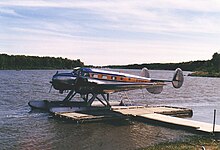
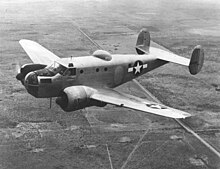

By the late 1930s, Beechcraft management speculated that a demand would exist for a new design dubbed the Model 18, which would have a military application, and increased the main production facilities. The design was mainly conventional for the time, including twin radial engines, all-metal semimonocoque construction with fabric-covered control surfaces, and tailwheel undercarriage. Less conventional was the twin-tailfin configuration. The Model 18 can be mistaken for the larger Lockheed Electra series of airliners, which closely resemble it. Early production aircraft were powered either by two 330-hp (250-kW) Jacobs L-6s or 350-hp (260-kW) Wright R-760Es. The 450-hp (336-kW) Pratt & Whitney R-985 became the definitive engine from the prewar C18S onwards. The Beech 18 prototype first flew on January 15, 1937.
The aircraft has used a variety of engines and has had a number of airframe modifications to increase gross weight and speed. At least one aircraft was modified to a 600-hp (447-kW) Pratt & Whitney R-1340 powerplant configuration. With the added weight of about 200 lb (91 kg) per engine, the concept of a Model 18 fitted with R-1340 engines was deemed unsatisfactory due to the weakest structural area of the aircraft being the engine mounts. Nearly every airframe component has been modified.
In 1955, deliveries of the Model E18S commenced; the E18S featured a fuselage that was extended 6 in (150 mm) higher for more headroom in the passenger cabin. All later Beech 18s (sometimes called Super 18s) featured this taller fuselage, and some earlier models (including one AT-11) have been modified to this larger fuselage. The Model H18, introduced in 1963, featured optional tricycle undercarriage. Unusually, the undercarriage was developed for earlier-model aircraft under an STC by Volpar, and installed in H18s at the factory during manufacture. A total of 109 H18s was built with tricycle undercarriage, and another 240 earlier-model aircraft were modified with this.[8][9]
Construction of the Beechcraft Model 18 ended in 1970 with a final Model H18 going to Miyazaki Aviation College, Japan.[10] Through the years, 32 variations of the basic design had flown, over 200 improvement modification kits were developed, and almost 8,000 aircraft were built. In one case, the aircraft was modified to a triple tail, trigear, humpbacked configuration and appeared similar to a miniature Lockheed Constellation.[11] Another distinctive conversion was carried out by Pacific Airmotive as the PacAero Tradewind. This featured a lengthened nose to accommodate the tricycle nosewheel, and the Model 18's twin tailfins were replaced by a single fin.[12]
Operational history
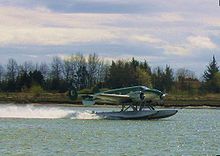
Production got an early boost when Nationalist China paid the company US$750,000 for six M18R light bombers,[13] but by the time of the U.S. entry into World War II, only 39 Model 18s had been sold, of which 29 were for civilian customers.[8][14] Work began in earnest on a variant specifically for training United States Army Air Forces (USAAF) military pilots, bombardiers, and navigators. The effort resulted in the Army AT-7. Further development led to the AT-11 navigation trainer, C-45 military transport, and F-2 (the "F" standing for "Fotorecon", short for "photographic reconnaissance"). The United States Navy first adopted the Beech 18 as the JRB-1, equivalent to the F-2, followed by the JRB-2 transport; the JRB was initially named the Voyager, but this name did not enter common use, and JRBs were generally called Expeditors like their USAAF counterparts.[15] The first JRB-1 obtained by the Navy, bureau number (BuNo) 09771, was converted from the last civil Model 18 built before production was earmarked solely for the military for the duration of the war.[16] The Navy subsequently obtained more Model 18s as the JRB-3 (C-45B), JRB-4 (UC-45F), SNB-1 Kansan (AT-11), SNB-2 (AT-7), and SNB-2C (AT-7C).[17] Existing naval Twin Beeches were subsequently modified into the SNB-2H air ambulance, SNB-2P reconnaissance trainer, and SNB-3Q electronic countermeasures trainer.[18] The United States Coast Guard acquired seven JRB-4 and JRB-5 aircraft from the Navy between 1943 and 1947; they were primarily used as utility transports, with one aircraft later converted for aerial mapping, and another used for proficiency flying.[19][20]
After the war, the USAAF became the United States Air Force (USAF), and the USAF Strategic Air Command had Model 18 variants (AT-11 Kansans, C-45 Expeditors, F-2 Expeditors, and UC-45 Expeditors) from 1946 until 1951. In 1950, the Navy still had around 1,200 JRB and SNB aircraft in inventory.[18] From 1951 to 1955, the USAF had many of its aircraft remanufactured with new fuselages, wing center sections, and undercarriages to take advantage of the improvements to the civil models since the end of World War II. Eventually, 900 aircraft were remanufactured to be similar to the then-current Model D18S and given new designations, constructor's numbers, and Air Force serial numbers.[21] The USN had many of its surviving aircraft remanufactured as well, resulting in the JRB-6, the SNB-5, and SNB-5P.[22] The Coast Guard retired its JRBs in 1956 and sold most of them as surplus in 1959, but one was retained by the United States Coast Guard Reserve until at least 1972.[19][20] With the adoption of the 1962 United States Tri-Service aircraft designation system, the Navy's SNB-5 and SNB-5P became the TC-45J and RC-45J respectively, later becoming the UC-45J as their primary mission shifted from aircrew training to utility transport work.[23] The C-45 flew in USAF service until 1963, the USN retired its last UC-45J in 1972, while the U.S. Army flew its C-45s until 1976. In later years, the military called these aircraft "bug smashers" in reference to their extensive use supplying mandatory flight hours for desk-bound aviators in the Pentagon.[24]
Beech 18s were used extensively by Air America during the Vietnam War; initially more-or-less standard ex-military C-45 examples were used, but then the airline had 12 aircraft modified by Conrad Conversions in 1963 and 1964 to increase performance and load-carrying capacity. The modified aircraft were known as Conrad Ten-Twos, as the maximum takeoff weight (MTOW) was increased to 10,200 lb (4,600 kg).[25][26] The increase was achieved by several airframe modifications, including increased horizontal stabilizer angle-of-incidence, redesigned undercarriage doors, and aerodynamically improved wingtips. Air America then had Volpar convert 14 aircraft to turboprop power, fitted with Garrett AiResearch TPE-331 engines; modified aircraft were called Volpar Turbo Beeches, and also had a further increase in MTOW to 10,286 lb (4,666 kg).[25]
Spar problems
The wing spar of the Model 18 was fabricated by welding an assembly of tubular steel. The configuration of the tubes in combination with drilled holes from aftermarket STC modifications on some of these aircraft have allowed the spar to become susceptible to corrosion and cracking while in service.[27] This prompted the FAA to issue an Airworthiness Directive in 1975, mandating the fitting of a spar strap to some Model 18s. This led, in turn, to the retirement of a large number of STC-modified Model 18s when owners determined the aircraft were worth less than the cost of the modifications. The corrosion on unmodified spars was not a problem; it occurred due to the additional exposed surface area created through the STC hole-drilling process. Further requirements have been mandated by the FAA and other national airworthiness authorities, including regular removal of the spar strap to allow the strap to be checked for cracks and corrosion and the spar to be X-rayed. In Australia, the airworthiness authority has placed a life limit on the airframe, beyond which aircraft are not allowed to fly.[28][29][30]
Variants
Manufacturer models
Unless otherwise noted, the engines fitted are Pratt & Whitney R-985 radials.
- Model 18A
- First production model with seating for two pilots and seven or eight passengers, fitted with Wright R-760E-2 engines of 350 horsepower (260 kW), MTOW: 6,700 lb (3,000 kg)[31][32] Four built.[33]
- Model S18A
- Version of Model 18A capable of being fitted with skis or Edo 55-7170 floats; MTOW: 7,200 lb (3,300 kg)[32]
- Model A18A
- Version fitted with Wright R-760E-2 engines, MTOW: 7,500 lb (3,400 kg)[34]
- Model SA18A
- Seaplane version of Model A18A, MTOW: 7,170 lb (3,250 kg)[34]
- Model 18B
- Version powered with 285 hp (213 kW) Jacobs L-5 engines. Four built.[35][33]
- Model S18B
- Version of Model 18B capable of being fitted with skis or floats.
- Model 18D
- Variant with seating for two pilots and nine passengers, fitted with Jacobs L-6 engines of 330 horsepower (250 kW), MTOW: 7,200 lb (3,300 kg).[34] Twelve aircraft built.[33]
- Model S18D
- Version of Model 18D capable of being fitted with skis or Edo 55-7170 floats[citation needed], MTOW: 7,170 lb (3,250 kg)[14][failed verification][34]
- Model A18D
- Variant of 18D with MTOW increased by 300 lb (140 kg) to 7,500 lb (3,400 kg).[34]
- Model SA18D
- Seaplane version of Model A18D, but same MTOW as S18D.[34]
- Model 18R
- Model with Pratt and Whitney R-985-A1 engines with dual-stage blower for increased power at higher operating altitudes[citation needed], 420 horsepower (310 kW), seven built, one to Sweden as an air ambulance, six to Nationalist China as M18R light bombers[13][33]
- Model 18S
- Nine-passenger pre-World War II civil variant, powered by 450 hp (340 kW) served as basis for USAAF C-45C[1]
- Model B18S
- Nine-passenger pre-World War II civil variant, served as basis for USAAF F-2[1]
- Model C18S
- Variant of B18S with seating for eight passengers, and equipment and minor structural changes[36]
- Model D18S
- First post-World War II variant introduced in 1945, with seating for eight passengers and MTOW of 8,750 lb (3,970 kg), 1,035 built[37][38]
- Model D18C
- Variant with Continental R9-A engines of 525 horsepower (391 kW) and MTOW of 9,000 lb (4,100 kg), introduced in 1947, 31 built.[37][39]
- Model E18S

- Variant with redesigned wing and MTOW of 9,300 lb (4,200 kg); 403 built[37]
- Model E18S-9700
- Variant of E18S with MTOW of 9,700 lb (4,400 kg); 57 built[37]
- Model G18S
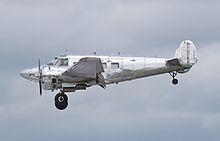
- Model H18
- Last production version, fitted with optional tricycle undercarriage developed by Volpar and MTOW of 9,900 lb (4,500 kg); 149 built, of which 109 were manufactured with tricycle undercarriage[8][37][38]
Military versions
USAAC/USAAF designations
- RC-45A
- Redesignation of all surviving F-2, F-2A, and F-2B aircraft by the USAF in 1948
- C-45B
- Based on C18S, but with modified internal layout; 223 ordered, redesignated UC-45B in 1943[36][41] Equipped with a hatch in the cabin door for aerial photography.[42]
- C-45C
- Two Model 18S aircraft impressed into the USAAF, redesignated UC-45C in January 1943[1][31][43]
- C-45D
- Designation given to two AT-7 aircraft converted as passenger transports during manufacture, redesignated UC-45D in January 1943[43][44]
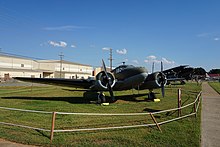

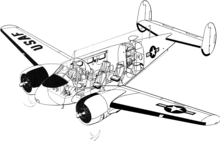
- C-45E
- Designation given to two AT-7 and four AT-7B aircraft converted as passenger transports during manufacture, redesignated UC-45E in January 1943[43][44]
- C-45F
- Standardized seven-seat version based on C18S, with longer nose than preceding models;[36] 1,137 ordered, redesignated UC-45F[41]
- C-45G
- AT-7s and AT-11s remanufactured in the early 1950s for the USAF to similar standard as civil D18S with autopilot and R-985-AN-3 engines; 372 aircraft rebuilt[21][45]
- TC-45G
- Multiengine crew trainer variant of C-45G; AT-7s and AT-11s remanufactured in the early 1950s for the USAF to similar standard as civil D18S, 96 aircraft rebuilt[21][45]
- C-45H
- AT-7s and AT-11s remanufactured in the early 1950s for the USAF to similar standard as civil D18S, with no autopilot and R-985-AN-14B engines; 432 aircraft rebuilt[21][46]
- TC-45H [37]


- AT-7 Navigator
- Navigation trainer based on C18S,[36] with an astrodome and positions for three students, powered by 450-hp Pratt & Whitney R-985-25 engines; 577 built[40][41]
- AT-7A
- Floatplane version of AT-7; six built[40]
- AT-7B
- Winterised AT-7; nine built[40]
- AT-11 Kansan
- Bombing and gunnery trainer for USAAF derived from AT-7, fuselage had small, circular cabin windows, bombardier position in nose, and bomb bay; gunnery trainers were also fitted with two or three .30-caliber machine guns, early models (the first 150 built) had a single .30-cal AN-M2 in a Beechcraft-manufactured top turret, later models used a Crocker Wheeler twin .30-cal top turret, a bottom tunnel gun was used for tail gunner training, 1,582 built for USAAF orders, with 24 ordered by Netherlands repossessed by USAAF and used by the Royal Netherlands Military Flying School at Jackson, Mississippi.[47][48]
- AT-11A
- Conversion of AT-11 as navigation trainer; 36 converted[48]
- CQ-3
- Conversion of UC-45F, modified to act as drone control aircraft, redesignated as DC-45F in June 1948[citation needed]
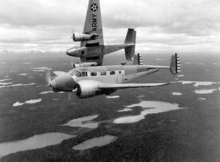
- F-2
- Photo-reconnaissance version based on B18[1]
- F-2A
- Improved version
- F-2B
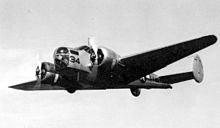
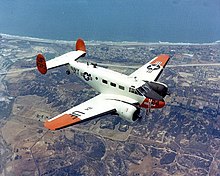
- JRB-1
- Photographic aircraft, based on the C18S,[36] fitted with fairing over cockpit for improved visibility, 11 obtained,[49] at least one conversion from impressed civil B18S[16]
- JRB-2
- Light transport, based on the C18S;[36] 15 obtained,[49] at least one conversion from JRB-1,[50] some transferred from USAAF C-45A stocks[51]
- JRB-3
- Photographic version, similar to C-45B; 23 obtained,[49] some transferred from USAAF C-45B stocks[52]
- JRB-6
- Remanufactured JRB[23]
- SNB-2H
- Ambulance conversion[18]
- SNB-2P
- Photo-reconnaissance trainer conversion[18]
- SNB-3Q
- Electronic countermeasures trainer conversion[18]
RAF/RCAF Lend-lease designations
- Expeditor I
- C-45Bs supplied to the RAF under Lend-Lease
- Expeditor II
- C-45Fs supplied to the RAF and Royal Navy under Lend-Lease

- Expeditor III
- C-45Fs supplied to the RCAF under Lend-Lease
Post-war RCAF designations
C-45Ds delivered between 1951 and 1952[57]
- Expeditor 3N
- navigation trainer - 88 built[58]
- Expeditor 3NM
- navigational trainer that could be converted to a transport - 59 built[59]
- Expeditor 3NMT
- 3NM converted to a transport aircraft - 67 built[60]
- Expeditor 3NMT(Special)
- navigation trainer/personnel transport - 19 built[61]
- Expeditor 3TM
- transport with fittings so it could be converted to a navigation trainer - 44 built[58]
- Expeditor 3TM(Special)
- modified RCAF Expeditors used overseas in conjunction with Project WPB6 - three built[62]
Canadian Armed Forces
- CT-128 Expeditor
- 1968 redesignation of existing RCAF aircraft upon unification of the Canadian Armed Forces
Conversions
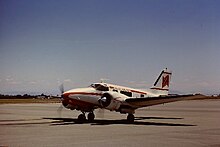
- Conrad 9800
- Modification increasing the gross weight to 9,800 pounds with a single piece windshield [63]
- Dumod I
- Executive conversion with Volpar tricycle landing gear, new wing tips, enlarged fight deck and refurbished 6–7 seat cabin with larger windows. Originally named Infinité I. 37 converted by 1966.[11]
- Dumod Liner
- Stretched airliner conversion. Similar to Dumod I but with forward fuselage stretched by 6 feet 3 inches (1.91 m), allowing up to 15 passengers to be carried. Originally named Infinité II.[11]
- Hamilton HA-1
- conversion of a TC-45J aircraft
- Hamilton Little Liner
- Modification of D18S with aerodynamic improvements and new, retractable tailwheel, capable of carrying 11 seats[64]
- Hamilton Westwind
- Turboprop conversions with various engines

- Hamilton Westwind II STD
- Stretched conversion powered by two 840-hp PT6As, and with accommodation for up to 17 passengers[65]
- Hamilton Westwind III
- two 579-hp PT6A-20s or 630-hp PT6A-27s or 630-hp Lycoming LTS101s.
- Hamilton Westwind IV
- two 570-hp Lycoming LTP101s or 680-hp PT6A-28s or 750-hp PT6A-34s or 1020-hp PT6A-45s
- PacAero Tradewind
- Conversion of Beech D18S/C-45 to five- to 11-seat executive transport with single fin by Pacific Airmotive
- Rausch Star 250
- Built as C-45F 44-47231, this aircraft was re-manufactured at Wichita by Beech in 1952, to become TC-45G 51-11544. From 1959 Rausch Engineering Inc. of South San Francisco, California, converted N8186H to tricycle undercarriage, using forward retracting main gear from a P-51 and rearward-retracting nose-leg from a T-28, adding a 3 ft (0.91 m) nose extension, 4 ft (1.22 m) rear fuselage extension, re-roofed fuselage for increased headroom and enlarged cabin windows. The modifications did not obtain FAA certification despite 58 hours of flight testing, with the aircraft eventually being broken up at Antioch, CA, in 1978.[66]
- SFERMA-Beechcraft PD.18S
- Modification of Beech 18S powered by two Turboméca Bastan turboprops[67]
- Volpar (Beechcraft) Model 18
- Conversion of Model 18 with nosewheel undercarriage[68][69]
- Volpar (Beechcraft) Super 18
- Volpar (Beechcraft) Turbo 18
- Beech Model 18s fitted with the Volpar MkIV tricycle undercarriage and powered by two 705-hp Garrett TPE331-1-101B turboprop engines, flat-rated to 605 hp (451 kW), driving Hartzell HC-B3TN-5 three-bladed, reversible-pitch, constant-speed feathering propellers[69]
- Volpar (Beechcraft) Super Turbo 18
- 2x 705 hp (526 kW) Garrett TPE331
- Volpar (Beechcraft) C-45G
- C-45G aircraft modified with tricycle undercarriage
- Volpar (Beechcraft) Turboliner
- 15-passenger version of the Turbo 18 with extended fuselage, powered by 2 705-hp Garrett TPE331-1-101Bs[70]
- Volpar (Beechcraft) Turboliner II
- Turboliners modified to meet SFAR 23[70]
Operators
Civil
As of 2012[update], the Beechcraft Model 18 remains popular with air charter companies and small feeder airlines worldwide.
Military







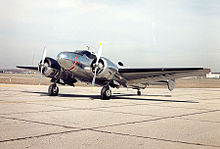
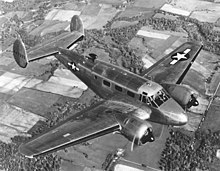

- Royal Canadian Air Force 394 examples from 1941 to 1972[74]
- Royal Canadian Navy 10 examples from 1952 to 1960[75]
- VX-10 Squadron[citation needed]
- VU-32 Squadron[76]
- Canadian Armed Forces
- Cuban Air Force - received two AT-7s, two AT-11s, a F-2B and a UC-45F in 1947[81]
Text je dostupný za podmienok Creative Commons Attribution/Share-Alike License 3.0 Unported; prípadne za ďalších podmienok. Podrobnejšie informácie nájdete na stránke Podmienky použitia.
Antropológia
Aplikované vedy
Bibliometria
Dejiny vedy
Encyklopédie
Filozofia vedy
Forenzné vedy
Humanitné vedy
Knižničná veda
Kryogenika
Kryptológia
Kulturológia
Literárna veda
Medzidisciplinárne oblasti
Metódy kvantitatívnej analýzy
Metavedy
Metodika
Text je dostupný za podmienok Creative
Commons Attribution/Share-Alike License 3.0 Unported; prípadne za ďalších
podmienok.
Podrobnejšie informácie nájdete na stránke Podmienky
použitia.
www.astronomia.sk | www.biologia.sk | www.botanika.sk | www.dejiny.sk | www.economy.sk | www.elektrotechnika.sk | www.estetika.sk | www.farmakologia.sk | www.filozofia.sk | Fyzika | www.futurologia.sk | www.genetika.sk | www.chemia.sk | www.lingvistika.sk | www.politologia.sk | www.psychologia.sk | www.sexuologia.sk | www.sociologia.sk | www.veda.sk I www.zoologia.sk
